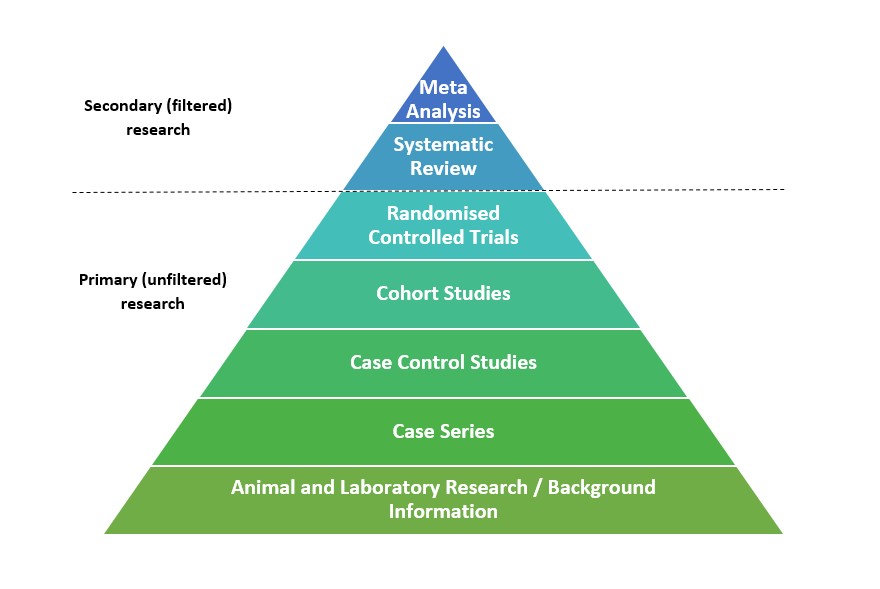Evidence based practice
Develop a focused clinical question
There are two main types of questions that may arise from a patient dilemma:
-
Background questions address general queries about a particular disease, condition, test or treatment and can often be answered sufficiently using medical textbooks or point-of-care tools (e.g. UpToDate).
-
Foreground questions address aspects of care, therapy options or possible outcomes in relation to a specific patient or situation and require a more in-depth literature search to find the answer.
Answering foreground questions involves developing well-formed, focused clinical questions.
The PICO framework
The PICO framework is commonly used to translate and structure patient dilemmas into focused questions. Using PICO helps to identify the important concepts for your search strategy and makes searching for evidence easier and more time effective.
| Patient, population or problem | What are the characteristics of the patient or population (e.g. disease or condition, age, gender?) |
| Intervention or exposure | What is the main intervention of interest (e.g. drug or other treatment, diagnostic/screening test)? |
| Comparison | What is the alternative being considered (e.g. standard therapy, placebo, no treatment)? |
| Outcomes | What are the relevant outcomes (e.g. reduced risk or mortality, return to function, accurate diagnosis)? |
Jack is a 40 year-old bricklayer who has been experiencing intermittent low back pain over the last few weeks. He has been taking Panadol to alleviate the pain but his friend who also experiences back pain suggested trying Ibuprofen instead. As his general practitioner (GP), Jack has asked you whether Ibuprofen is better than Panadol for back pain.
Step 1: Identify the PICO elements from the patient dilemma
P - Adult with low back pain
I - Ibuprofen
C - Panadol
O - Reduced back pain
Step 2: Use the PICO elements to formulate the clinical question
In adults with low back pain (P), is Ibuprofen (I) compared to Panadol (C) more effective in reducing back pain (O)
Types of studies
What type of study best fits your focused clinical question? The evidence pyramid is used to illustrate the evolution of the literature. It ranks study types based on the rigour (strength and precision) of their research methodology. As you move up the pyramid the amount of available literature decreases, but increases in its relevance to the clinical setting.

-
A Meta-Analysis uses statistical methods to synthesise the data from individual studies in a systematic review.
-
A Systematic Review is a review based on a clearly formulated question. It uses systematic and reproducible methods to identify, select and critically appraise all relevant research, and to collect and analyse data from the studies that are included in the review.
-
Randomised Controlled Trials (RCTs) are study designs that randomly assign participants to an experimental group (receives a clinical intervention) or a control group (receives a placebo, the standard treatment or no intervention).
-
Cohort Studies are observational studies that identify two groups (cohorts) of patients, one which received the exposure of interest/intervention and one which did not, and follows them forward for the outcome.
-
Case Control Studies identify patients with a specific condition (cases) and patients without the condition (controls) and look back to see if they had an exposure of interest. They often rely on medical records and patient recall for data collection.
-
Case Series consist of a group or series of case reports involving patients with an outcome of interest. As they are reports of cases and use no control groups they have no statistical validity.
-
Animal and Laboratory Research/Background information includes animal research, and laboratory studies and testing.
Study design
PICO can be extended to PICOS where S stands for Study design. The following table outlines suitable study designs to answer a clinical question. Meta-analyses and systematic reviews where available, will often provide the best answers to clinical questions.
| Question type | Definition | Best study design |
|---|---|---|
| Therapy | The effect of an intervention/s on a patient | Randomised Controlled Trial (RCT) |
| Diagnosis | Ability of a test to differentiate between those with or without a condition | Prospective, blind comparison to a gold standard |
| Harm/etiology | The effect of potentially harmful agents | Cohort study or Case control study |
| Prognosis | The likely progression, outcome or survival time for a condition | Cohort study |
| Prevention | Reducing chance of a disease by changing risk factors or early diagnosis & treatment | RCT |
For the clinical question In adults with low back pain, is Ibuprofen compared to Panadol more effective in reducing back pain we are looking at the effect of a drug on a patient. This is a therapy question; the best study design would be a RCT.
PICo (Qualitative)
Qualitative questions look at people’s experiences, attitudes, beliefs, opinions, perceptions etc. A modified framework, PICo, can be used for these types of questions. PICo stands for Population, Interest and Context. For more information on answering qualitative questions, please see: